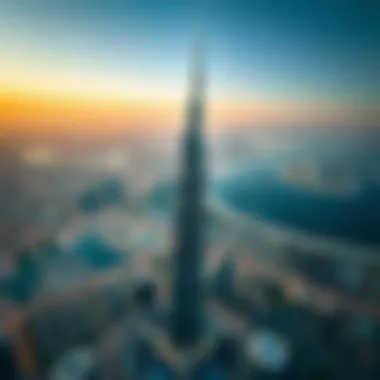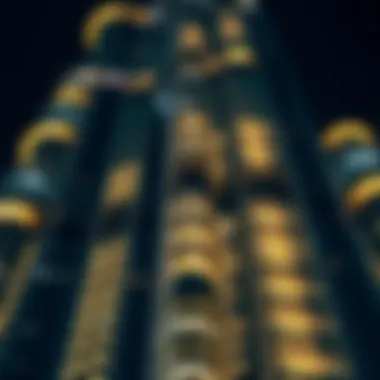Understanding the Cost of Burj Khalifa in Rupees


Intro
The Burj Khalifa stands tall as not just an architectural wonder, but also as a significant indicator of economic ambitions. When we talk about the cost of this mammoth structure, it goes beyond dollars and cents, especially when converted to Indian rupees. The sheer scale, from its height to the intricacies of design, hints at extraordinary financial implications. As luxury real estate continues to evolve, understanding the expenses involved in such landmarks becomes crucial for investors and buyers alike.
In this article, we will take a closer look at the construction cost, the financial trees this structure suspended amidst its background, and how it plays into both local and global markets. A thorough examination of these points will hopefully equip potential investors and even seasoned realtors with insights that could shape their strategies in a competitive landscape. Each segment sheds light on particular aspects, from the direct costs related to the Burj Khalifa's development to larger market trends shaped by such iconic structures.
Our journey through numbers, projections, and analyses will offer a clearer picture of what investing in properties akin to the Burj Khalifa could entail. Ultimately, this discussion aims to bridge luxury and investment opportunity within a realm often perceived as distant and exclusive.
Market Trends
A structure like the Burj Khalifa doesn’t merely change the skyline of Dubai; it ripples through the real estate market on a global scale. By analyzing market trends, potential investors can gauge how such influences shift property values and investments.
Current Market Analysis
When examining the current situation, it becomes clear that high-value properties continue to attract not just locals, but also international attention. The Burj Khalifa, with its price tag rising substantially when evaluated in rupees, showcases the allure of luxury amidst promising ROI (return on investment).
As of the latest reports, luxury apartments in Dubai show a 10% increase, significantly buoyed by iconic landmarks like the Burj Khalifa. Investors are keenly aware of these figures, knowing that the location can often supersede the actual property amenities.
To truly grasp the scale of potential returns, consider how iconic structures often correlate with booming tourist activity and affluent consumer demographics. Such dynamics can elevate property values significantly.
Prolusion to Burj Khalifa


The Burj Khalifa holds a special place in the hearts of many around the globe. It’s not just an architectural wonder soaring at 828 meters; it serves as a key player in understanding how significant landmarks influence economies. This article will particularly zero in on the costs associated with its construction and what that figures translates into when looked at in Indian Rupees.
The topic encompasses a variety of elements that reveal how an iconic structure like the Burj Khalifa can have rippling effects on the market. From its stunning architecture to its multifaceted construction history and the resulting economic implications, each facet adds a layer of complexity. As we dissect the costs behind its creation, we'll explore how those figures reflect on real estate investments and trends worldwide. It’s vital for investors, realtors, and analysts to grasp not only the dollar amount but also the broader significance that these costs carry.
In short, understanding Burj Khalifa's financial journey lays a foundation for predicting future trends in luxury real estate and architecture.
Significance of Burj Khalifa
The Burj Khalifa is more than just a towering structure; it's a beacon of innovation and aspiration. Built in a city that has transformed dramatically over the last few decades, its significance stretches far beyond its height. Serving as a residence, office space, and a luxurious hotel, the building symbolizes what's possible in modern construction. Moreover, it represents the ambitious spirit of Dubai and serves as a catalyst for tourism. More visitors flock to see it than to many other landmarks worldwide, thus contributing substantially to the local economy. This gravitational pull of tourists and business travelers simply amplifies its importance.
In addition, from a financial viewpoint, the Burj Khalifa attracts various forms of investment. Luxury brands often establish their presence within its confines, leading to increased visibility and foot traffic. Therefore, its significance is not just architectural; it's entwined with economic prosperity as well.
Overview of Construction History
The construction of the Burj Khalifa began in 2004 and met its grand opening in 2010, an impressive timeline for such an ambitious project. Initially, the project was aimed at revitalizing a developing area and driving urban growth in Dubai. Various challenges came knocking during the construction phase, from the harsh heat of the desert to engineering difficulties that needed innovative solutions.
The primary contractor, Samsung C&T, alongside several international firms, contributed their expertise. Techniques once thought to be on the fringe of engineering were employed to complete the skyscraper. It’s noteworthy that the construction was closely monitored for quality and safety, factors which ultimately influenced the cost.
Through the years, the project reflected a blend of art and science, and upon completion, it became a case study in luxury and innovation. As a destination, it provides not just breathtaking views but also a unique understanding of what it takes to bring a vision of this magnitude to life. Each bolt and beam in the Burj Khalifa narrates a story of the meticulous planning and execution required in super-tall buildings.
Understanding the history progressive in determining the financial viability of such projects ensures that current and future investors can glean valuable insights from its success.
Detailed Breakdown of Construction Costs


Understanding the financial outlay for constructing the Burj Khalifa provides invaluable insight into not just the edifice itself but also into the broader implications for those interested in real estate investment and development. Analyzing detailed construction costs is essential to uncovering why a structure of this magnitude commands a particular price tag, and how that correlates with the local and global markets. This section covers initial estimates compared to final expenditures, identifying key factors that drive costs, which can be pivotal for investors and realtors alike.
Initial Estimates versus Final Costs
In the world of mega-structures, initial estimates often serve as mere roundabout figures that are adjusted throughout the building process. The Burj Khalifa was no exception. Initially projected to cost around $1 billion dollars, its ultimate financial commitment exceeded $1.5 billion. This shift underscores the unpredictability of large-scale construction projects.
Several issues contributed to this cost escalation:
- Soil stability assessments, which required comprehensive tests and adjustments to the foundational approach to accommodate the tall structure.
- Material costs surged over the years, with certain components, like glass and steel, experiencing volatile pricing trends.
- Labor costs increased, fueled by the demand for skilled workers proficient in the new technologies required for such a height and architecture.
Thus, it becomes evident that anyone looking towards investing in similar projects must account for the variability in estimates, as staying within budgets in this domain can be exceedingly challenging.
Key Factors Influencing Costs
Cost overruns often stem from a blend of numerous factors. In the case of the Burj Khalifa, the following elements played significant roles in shaping the eventual financial picture:
- Engineering Complexity: Constructing the tallest building in the world required innovative engineering solutions that had not been previously tested. The architecture called for advanced materials and techniques that inevitably added to the cost.
- Geographical Challenges: Located in a desert environment, unique challenges related to climate and land usability influenced construction strategies, ultimately escalating expenses.
- Design Changes: Throughout the construction, changes in design—often prompted by aesthetic, safety, or functionality concerns—led to additional costs that were not part of the original budget.
Understanding these factors is crucial for investors, as they signal potential areas of risk and opportunity in future high-rise projects.
The Burj Khalifa serves as a case study on how financial and engineering challenges intertwine, providing key lessons for prospective developers.


By keeping these considerations in mind, investors can navigate the complexities of construction costs with more astute awareness, especially in high-end projects that require meticulous planning and forecasting. In the following sections, we will delve deeper into conversion processes of costs into rupees, as well as compare these insights against other global landmarks.
Conversion of Burj Khalifa Costs to Rupees
The Burj Khalifa stands as a monumental feat not only in architectural design but also in the realm of financial investment. Understanding the cost of this towering structure in Indian rupees is crucial for potential investors, real estate analysts, and luxury property seekers. While international currencies often fluctuate, having a localized perspective is key for making informed decisions.
Analyzing Burj Khalifa's cost in rupees reveals not just the sheer expenditure associated with its construction but also how it reflects on broader economic trends. The knowledge gained from this conversion can help stakeholders assess the feasibility of similar projects and understand the financial implications of investing in high-rise urban spaces.
A few benefits of converting costs to rupees include:
- Enhanced Comparability: Investors can better compare costs across different projects in India.
- Market Insight: Reflecting local currency offers insights into how mega-structures impact the real estate market in India.
- Investment Strategies: Knowing the costs in familiar currency allows for drawing up effective investment strategies based on return expectations.
By taking a closer look at the exchange rate and ultimately converting the total cost, this section aims to clarify how the project sits in the larger financial landscape of both the UAE and India, paving the way for a deeper understanding of real estate investment nuances.
Exchange Rate Analysis
When translating the Billions of Dirhams spent on Burj Khalifa into Indian rupees, the exchange rate plays a pivotal role. It fluctuates based on various economic factors, including interest rates, inflation, and market demand. As of the latest data, 1 UAE Dirham is approximately equal to 22 Indian rupees.
It’s important to keep an eye on these exchange rates, as even the slightest shift can alter financial planning significantly. For instance, if the exchange rate were to rise, the cost converted into rupees would appear more substantial, impacting investors’ perceptions and strategies. Similarly, a declining rate could offer a more favorable outlook for those looking to invest.
Understanding the exchange rate dynamics not only provides clarity on the Burj Khalifa’s cost but also helps highlight potential risks and rewards for investors transacting in different currencies.
Total Cost in Rupees
The total construction cost of Burj Khalifa wavered around 1.5 billion UAE Dirhams. To convert this into rupees, one takes the mentioned exchange rate:
Total Cost in Rupees = Total Cost in Dirhams × Exchange Rate
Total Cost in Rupees = 1,500,000,000 AED × 22 INR/AED
Total Cost in Rupees = 33,000,000,000 INR



